Nepal Earthquake and its Impact on Tourism and Hospitality Operations
VerifiedAdded on 2023/06/05
|12
|2612
|339
Report
AI Summary
This report examines the impact of the 2015 Nepal earthquake on the tourism and hospitality industry, focusing on disaster management strategies. It provides an overview of the event's impact, including infrastructure damage and loss of life, and analyzes the industry's response and recovery efforts. The report proposes a recommended policy draft addressing legal and regulatory concerns, policy objectives, and stakeholder involvement. It emphasizes the importance of risk mitigation, emergency response planning, and adherence to building codes. The analysis includes a critical evaluation of the Nepal's National DRR Policy & Strategic Action Plan, and the National Building Code. The report also highlights the role of various stakeholders, including government, businesses, and customers, in ensuring safety and resilience. Recommendations include evacuation plans, alarm systems, training programs, and resource management. The report concludes with a validation of the proposed policy and emphasizes the need for coordinated disaster management plans to protect tourists and ensure the industry's sustainability.
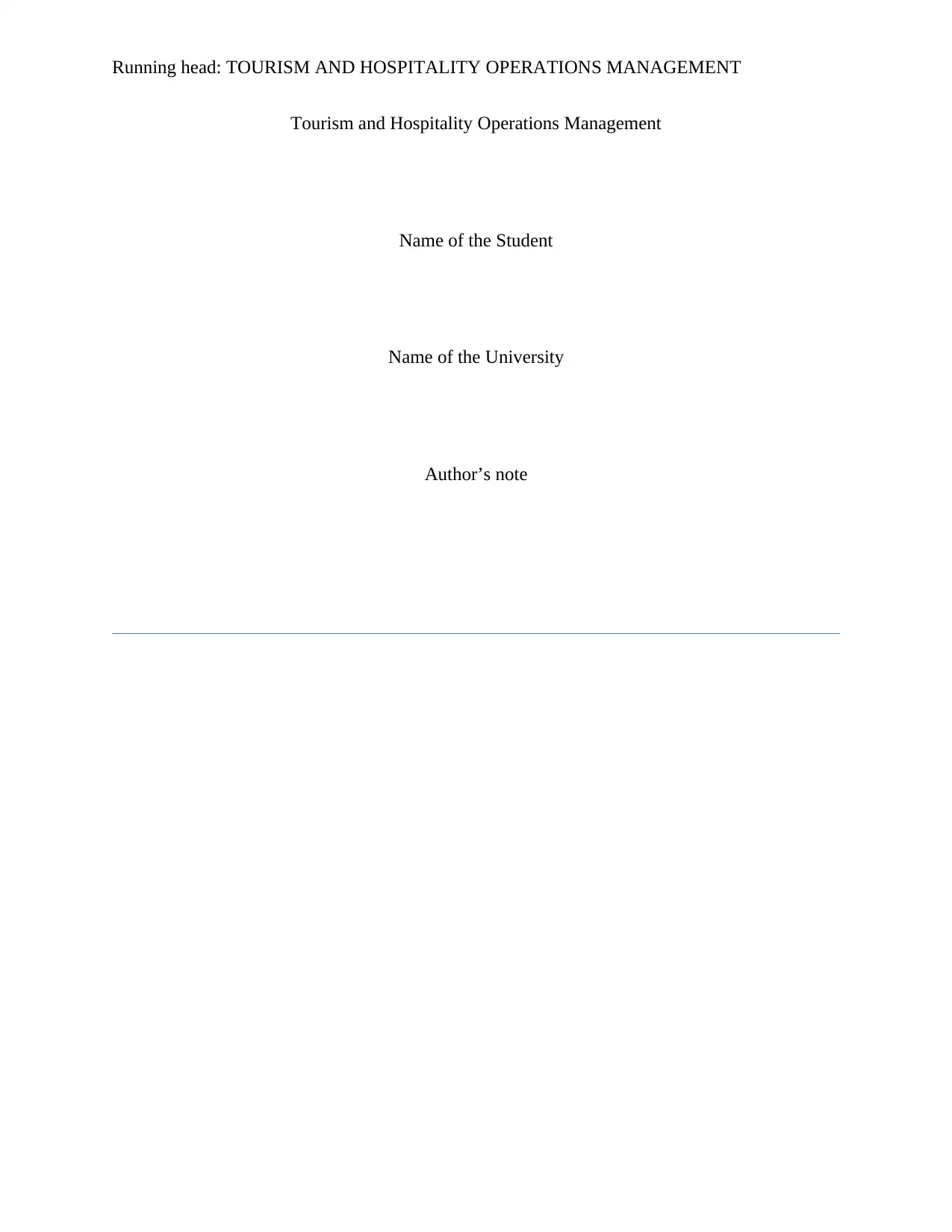
Running head: TOURISM AND HOSPITALITY OPERATIONS MANAGEMENT
Tourism and Hospitality Operations Management
Name of the Student
Name of the University
Author’s note
Tourism and Hospitality Operations Management
Name of the Student
Name of the University
Author’s note
Paraphrase This Document
Need a fresh take? Get an instant paraphrase of this document with our AI Paraphraser
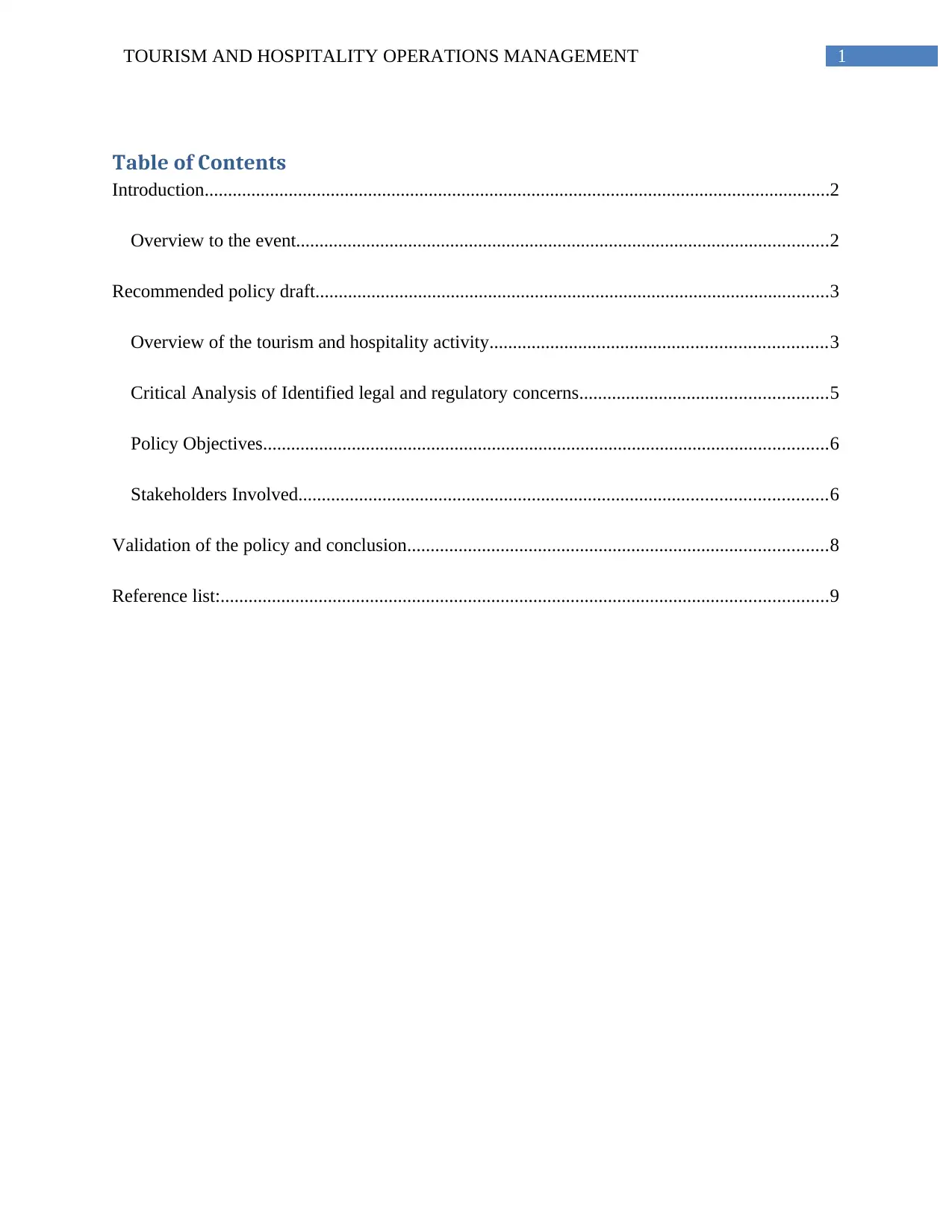
1TOURISM AND HOSPITALITY OPERATIONS MANAGEMENT
Table of Contents
Introduction......................................................................................................................................2
Overview to the event..................................................................................................................2
Recommended policy draft..............................................................................................................3
Overview of the tourism and hospitality activity........................................................................3
Critical Analysis of Identified legal and regulatory concerns.....................................................5
Policy Objectives.........................................................................................................................6
Stakeholders Involved.................................................................................................................6
Validation of the policy and conclusion..........................................................................................8
Reference list:..................................................................................................................................9
Table of Contents
Introduction......................................................................................................................................2
Overview to the event..................................................................................................................2
Recommended policy draft..............................................................................................................3
Overview of the tourism and hospitality activity........................................................................3
Critical Analysis of Identified legal and regulatory concerns.....................................................5
Policy Objectives.........................................................................................................................6
Stakeholders Involved.................................................................................................................6
Validation of the policy and conclusion..........................................................................................8
Reference list:..................................................................................................................................9
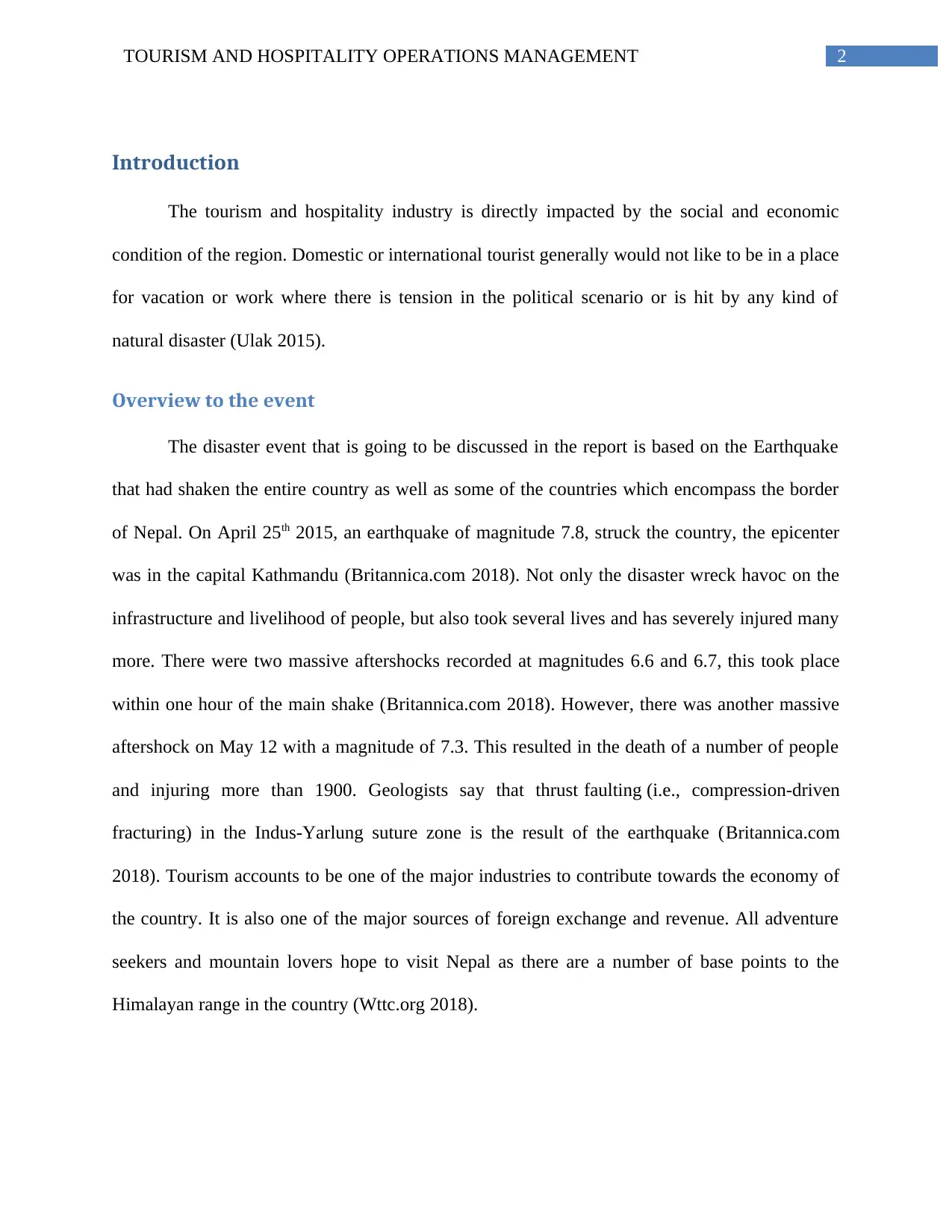
2TOURISM AND HOSPITALITY OPERATIONS MANAGEMENT
Introduction
The tourism and hospitality industry is directly impacted by the social and economic
condition of the region. Domestic or international tourist generally would not like to be in a place
for vacation or work where there is tension in the political scenario or is hit by any kind of
natural disaster (Ulak 2015).
Overview to the event
The disaster event that is going to be discussed in the report is based on the Earthquake
that had shaken the entire country as well as some of the countries which encompass the border
of Nepal. On April 25th 2015, an earthquake of magnitude 7.8, struck the country, the epicenter
was in the capital Kathmandu (Britannica.com 2018). Not only the disaster wreck havoc on the
infrastructure and livelihood of people, but also took several lives and has severely injured many
more. There were two massive aftershocks recorded at magnitudes 6.6 and 6.7, this took place
within one hour of the main shake (Britannica.com 2018). However, there was another massive
aftershock on May 12 with a magnitude of 7.3. This resulted in the death of a number of people
and injuring more than 1900. Geologists say that thrust faulting (i.e., compression-driven
fracturing) in the Indus-Yarlung suture zone is the result of the earthquake (Britannica.com
2018). Tourism accounts to be one of the major industries to contribute towards the economy of
the country. It is also one of the major sources of foreign exchange and revenue. All adventure
seekers and mountain lovers hope to visit Nepal as there are a number of base points to the
Himalayan range in the country (Wttc.org 2018).
Introduction
The tourism and hospitality industry is directly impacted by the social and economic
condition of the region. Domestic or international tourist generally would not like to be in a place
for vacation or work where there is tension in the political scenario or is hit by any kind of
natural disaster (Ulak 2015).
Overview to the event
The disaster event that is going to be discussed in the report is based on the Earthquake
that had shaken the entire country as well as some of the countries which encompass the border
of Nepal. On April 25th 2015, an earthquake of magnitude 7.8, struck the country, the epicenter
was in the capital Kathmandu (Britannica.com 2018). Not only the disaster wreck havoc on the
infrastructure and livelihood of people, but also took several lives and has severely injured many
more. There were two massive aftershocks recorded at magnitudes 6.6 and 6.7, this took place
within one hour of the main shake (Britannica.com 2018). However, there was another massive
aftershock on May 12 with a magnitude of 7.3. This resulted in the death of a number of people
and injuring more than 1900. Geologists say that thrust faulting (i.e., compression-driven
fracturing) in the Indus-Yarlung suture zone is the result of the earthquake (Britannica.com
2018). Tourism accounts to be one of the major industries to contribute towards the economy of
the country. It is also one of the major sources of foreign exchange and revenue. All adventure
seekers and mountain lovers hope to visit Nepal as there are a number of base points to the
Himalayan range in the country (Wttc.org 2018).
⊘ This is a preview!⊘
Do you want full access?
Subscribe today to unlock all pages.

Trusted by 1+ million students worldwide
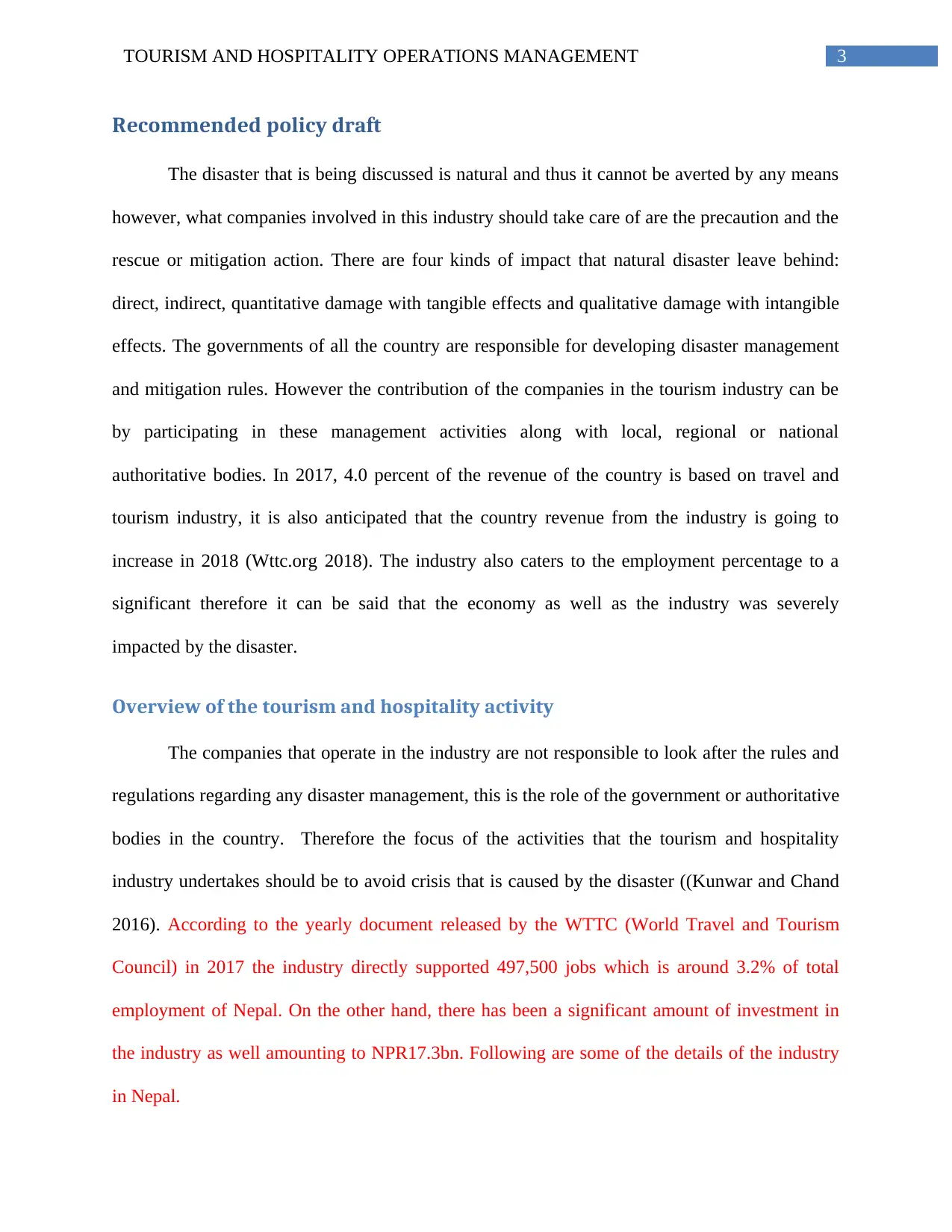
3TOURISM AND HOSPITALITY OPERATIONS MANAGEMENT
Recommended policy draft
The disaster that is being discussed is natural and thus it cannot be averted by any means
however, what companies involved in this industry should take care of are the precaution and the
rescue or mitigation action. There are four kinds of impact that natural disaster leave behind:
direct, indirect, quantitative damage with tangible effects and qualitative damage with intangible
effects. The governments of all the country are responsible for developing disaster management
and mitigation rules. However the contribution of the companies in the tourism industry can be
by participating in these management activities along with local, regional or national
authoritative bodies. In 2017, 4.0 percent of the revenue of the country is based on travel and
tourism industry, it is also anticipated that the country revenue from the industry is going to
increase in 2018 (Wttc.org 2018). The industry also caters to the employment percentage to a
significant therefore it can be said that the economy as well as the industry was severely
impacted by the disaster.
Overview of the tourism and hospitality activity
The companies that operate in the industry are not responsible to look after the rules and
regulations regarding any disaster management, this is the role of the government or authoritative
bodies in the country. Therefore the focus of the activities that the tourism and hospitality
industry undertakes should be to avoid crisis that is caused by the disaster ((Kunwar and Chand
2016). According to the yearly document released by the WTTC (World Travel and Tourism
Council) in 2017 the industry directly supported 497,500 jobs which is around 3.2% of total
employment of Nepal. On the other hand, there has been a significant amount of investment in
the industry as well amounting to NPR17.3bn. Following are some of the details of the industry
in Nepal.
Recommended policy draft
The disaster that is being discussed is natural and thus it cannot be averted by any means
however, what companies involved in this industry should take care of are the precaution and the
rescue or mitigation action. There are four kinds of impact that natural disaster leave behind:
direct, indirect, quantitative damage with tangible effects and qualitative damage with intangible
effects. The governments of all the country are responsible for developing disaster management
and mitigation rules. However the contribution of the companies in the tourism industry can be
by participating in these management activities along with local, regional or national
authoritative bodies. In 2017, 4.0 percent of the revenue of the country is based on travel and
tourism industry, it is also anticipated that the country revenue from the industry is going to
increase in 2018 (Wttc.org 2018). The industry also caters to the employment percentage to a
significant therefore it can be said that the economy as well as the industry was severely
impacted by the disaster.
Overview of the tourism and hospitality activity
The companies that operate in the industry are not responsible to look after the rules and
regulations regarding any disaster management, this is the role of the government or authoritative
bodies in the country. Therefore the focus of the activities that the tourism and hospitality
industry undertakes should be to avoid crisis that is caused by the disaster ((Kunwar and Chand
2016). According to the yearly document released by the WTTC (World Travel and Tourism
Council) in 2017 the industry directly supported 497,500 jobs which is around 3.2% of total
employment of Nepal. On the other hand, there has been a significant amount of investment in
the industry as well amounting to NPR17.3bn. Following are some of the details of the industry
in Nepal.
Paraphrase This Document
Need a fresh take? Get an instant paraphrase of this document with our AI Paraphraser
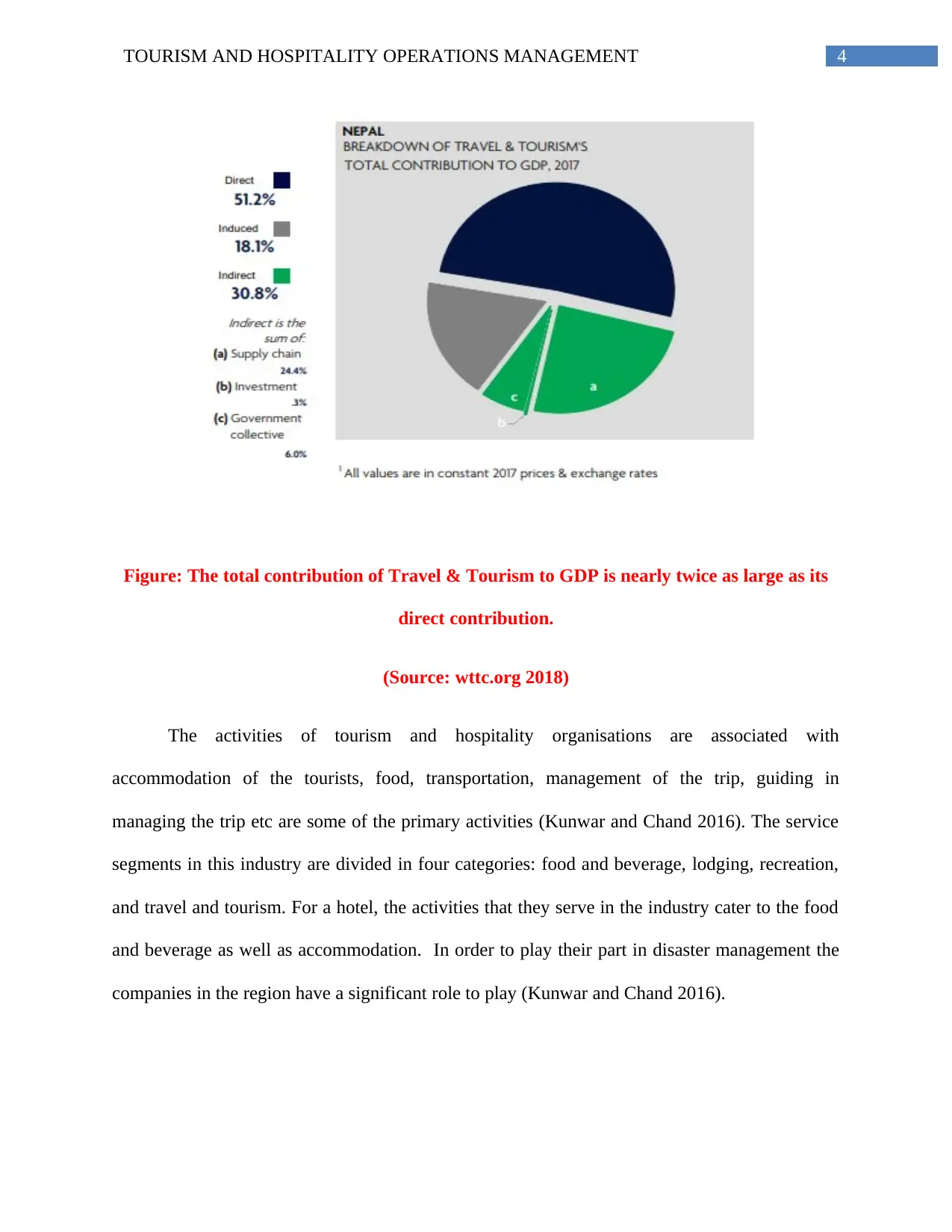
4TOURISM AND HOSPITALITY OPERATIONS MANAGEMENT
Figure: The total contribution of Travel & Tourism to GDP is nearly twice as large as its
direct contribution.
(Source: wttc.org 2018)
The activities of tourism and hospitality organisations are associated with
accommodation of the tourists, food, transportation, management of the trip, guiding in
managing the trip etc are some of the primary activities (Kunwar and Chand 2016). The service
segments in this industry are divided in four categories: food and beverage, lodging, recreation,
and travel and tourism. For a hotel, the activities that they serve in the industry cater to the food
and beverage as well as accommodation. In order to play their part in disaster management the
companies in the region have a significant role to play (Kunwar and Chand 2016).
Figure: The total contribution of Travel & Tourism to GDP is nearly twice as large as its
direct contribution.
(Source: wttc.org 2018)
The activities of tourism and hospitality organisations are associated with
accommodation of the tourists, food, transportation, management of the trip, guiding in
managing the trip etc are some of the primary activities (Kunwar and Chand 2016). The service
segments in this industry are divided in four categories: food and beverage, lodging, recreation,
and travel and tourism. For a hotel, the activities that they serve in the industry cater to the food
and beverage as well as accommodation. In order to play their part in disaster management the
companies in the region have a significant role to play (Kunwar and Chand 2016).
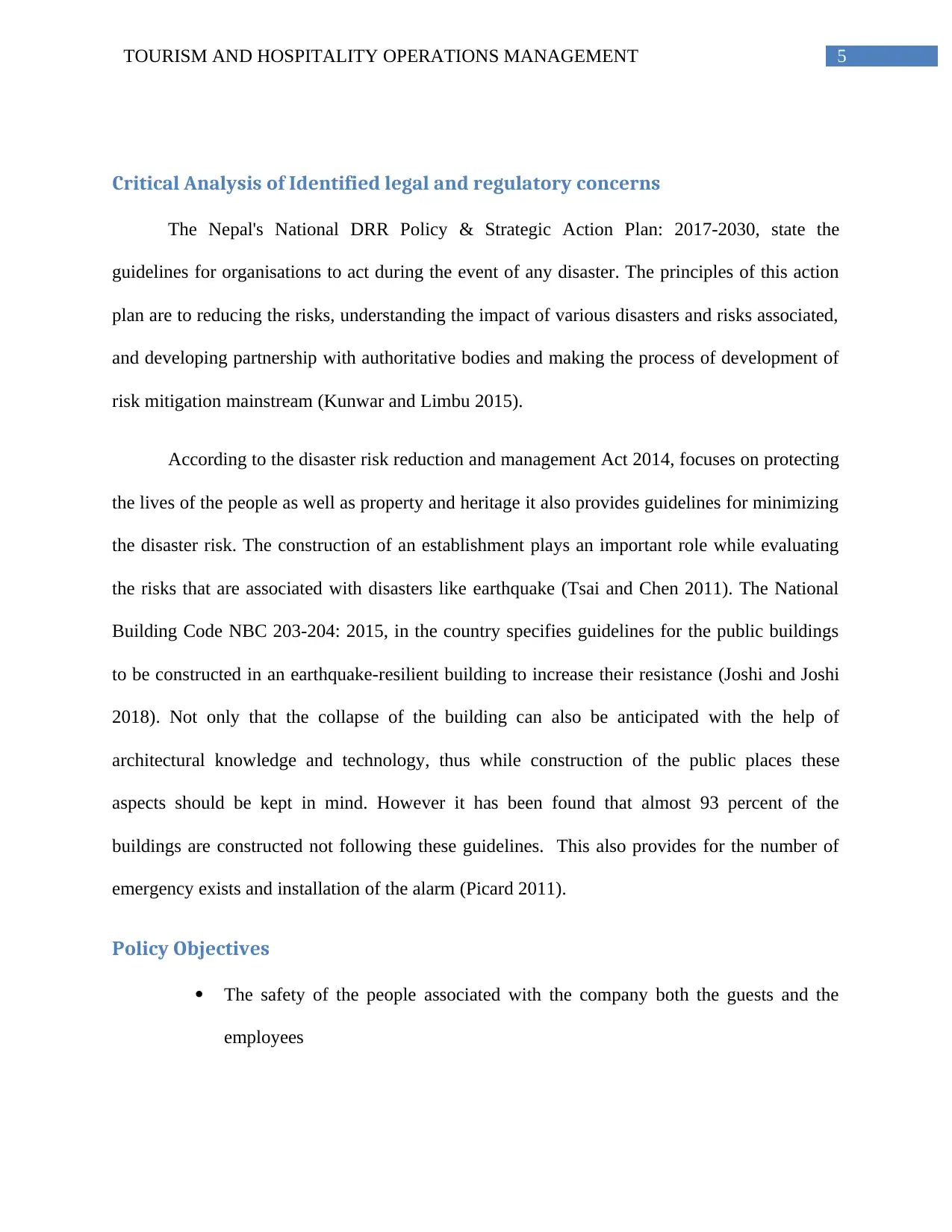
5TOURISM AND HOSPITALITY OPERATIONS MANAGEMENT
Critical Analysis of Identified legal and regulatory concerns
The Nepal's National DRR Policy & Strategic Action Plan: 2017-2030, state the
guidelines for organisations to act during the event of any disaster. The principles of this action
plan are to reducing the risks, understanding the impact of various disasters and risks associated,
and developing partnership with authoritative bodies and making the process of development of
risk mitigation mainstream (Kunwar and Limbu 2015).
According to the disaster risk reduction and management Act 2014, focuses on protecting
the lives of the people as well as property and heritage it also provides guidelines for minimizing
the disaster risk. The construction of an establishment plays an important role while evaluating
the risks that are associated with disasters like earthquake (Tsai and Chen 2011). The National
Building Code NBC 203-204: 2015, in the country specifies guidelines for the public buildings
to be constructed in an earthquake-resilient building to increase their resistance (Joshi and Joshi
2018). Not only that the collapse of the building can also be anticipated with the help of
architectural knowledge and technology, thus while construction of the public places these
aspects should be kept in mind. However it has been found that almost 93 percent of the
buildings are constructed not following these guidelines. This also provides for the number of
emergency exists and installation of the alarm (Picard 2011).
Policy Objectives
The safety of the people associated with the company both the guests and the
employees
Critical Analysis of Identified legal and regulatory concerns
The Nepal's National DRR Policy & Strategic Action Plan: 2017-2030, state the
guidelines for organisations to act during the event of any disaster. The principles of this action
plan are to reducing the risks, understanding the impact of various disasters and risks associated,
and developing partnership with authoritative bodies and making the process of development of
risk mitigation mainstream (Kunwar and Limbu 2015).
According to the disaster risk reduction and management Act 2014, focuses on protecting
the lives of the people as well as property and heritage it also provides guidelines for minimizing
the disaster risk. The construction of an establishment plays an important role while evaluating
the risks that are associated with disasters like earthquake (Tsai and Chen 2011). The National
Building Code NBC 203-204: 2015, in the country specifies guidelines for the public buildings
to be constructed in an earthquake-resilient building to increase their resistance (Joshi and Joshi
2018). Not only that the collapse of the building can also be anticipated with the help of
architectural knowledge and technology, thus while construction of the public places these
aspects should be kept in mind. However it has been found that almost 93 percent of the
buildings are constructed not following these guidelines. This also provides for the number of
emergency exists and installation of the alarm (Picard 2011).
Policy Objectives
The safety of the people associated with the company both the guests and the
employees
⊘ This is a preview!⊘
Do you want full access?
Subscribe today to unlock all pages.

Trusted by 1+ million students worldwide
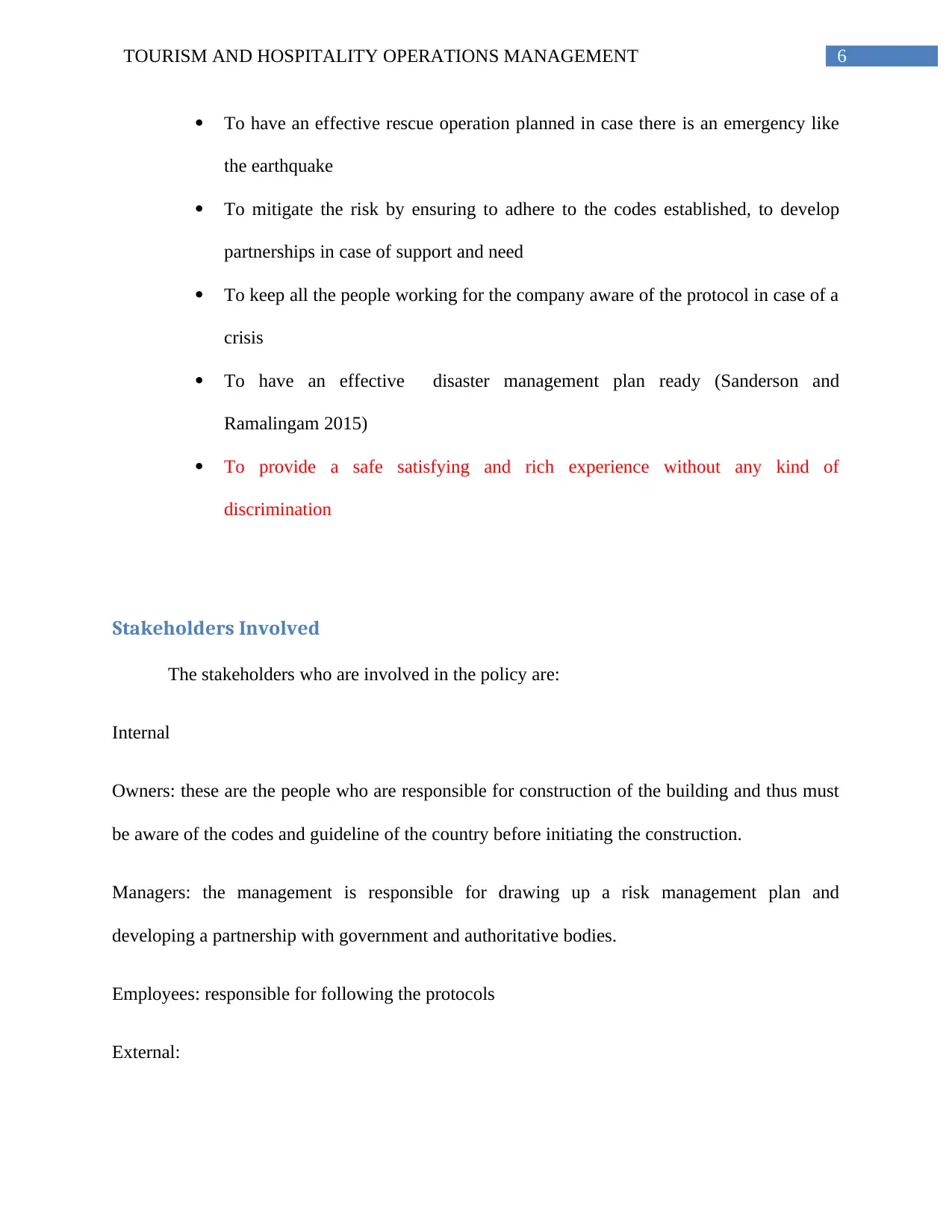
6TOURISM AND HOSPITALITY OPERATIONS MANAGEMENT
To have an effective rescue operation planned in case there is an emergency like
the earthquake
To mitigate the risk by ensuring to adhere to the codes established, to develop
partnerships in case of support and need
To keep all the people working for the company aware of the protocol in case of a
crisis
To have an effective disaster management plan ready (Sanderson and
Ramalingam 2015)
To provide a safe satisfying and rich experience without any kind of
discrimination
Stakeholders Involved
The stakeholders who are involved in the policy are:
Internal
Owners: these are the people who are responsible for construction of the building and thus must
be aware of the codes and guideline of the country before initiating the construction.
Managers: the management is responsible for drawing up a risk management plan and
developing a partnership with government and authoritative bodies.
Employees: responsible for following the protocols
External:
To have an effective rescue operation planned in case there is an emergency like
the earthquake
To mitigate the risk by ensuring to adhere to the codes established, to develop
partnerships in case of support and need
To keep all the people working for the company aware of the protocol in case of a
crisis
To have an effective disaster management plan ready (Sanderson and
Ramalingam 2015)
To provide a safe satisfying and rich experience without any kind of
discrimination
Stakeholders Involved
The stakeholders who are involved in the policy are:
Internal
Owners: these are the people who are responsible for construction of the building and thus must
be aware of the codes and guideline of the country before initiating the construction.
Managers: the management is responsible for drawing up a risk management plan and
developing a partnership with government and authoritative bodies.
Employees: responsible for following the protocols
External:
Paraphrase This Document
Need a fresh take? Get an instant paraphrase of this document with our AI Paraphraser
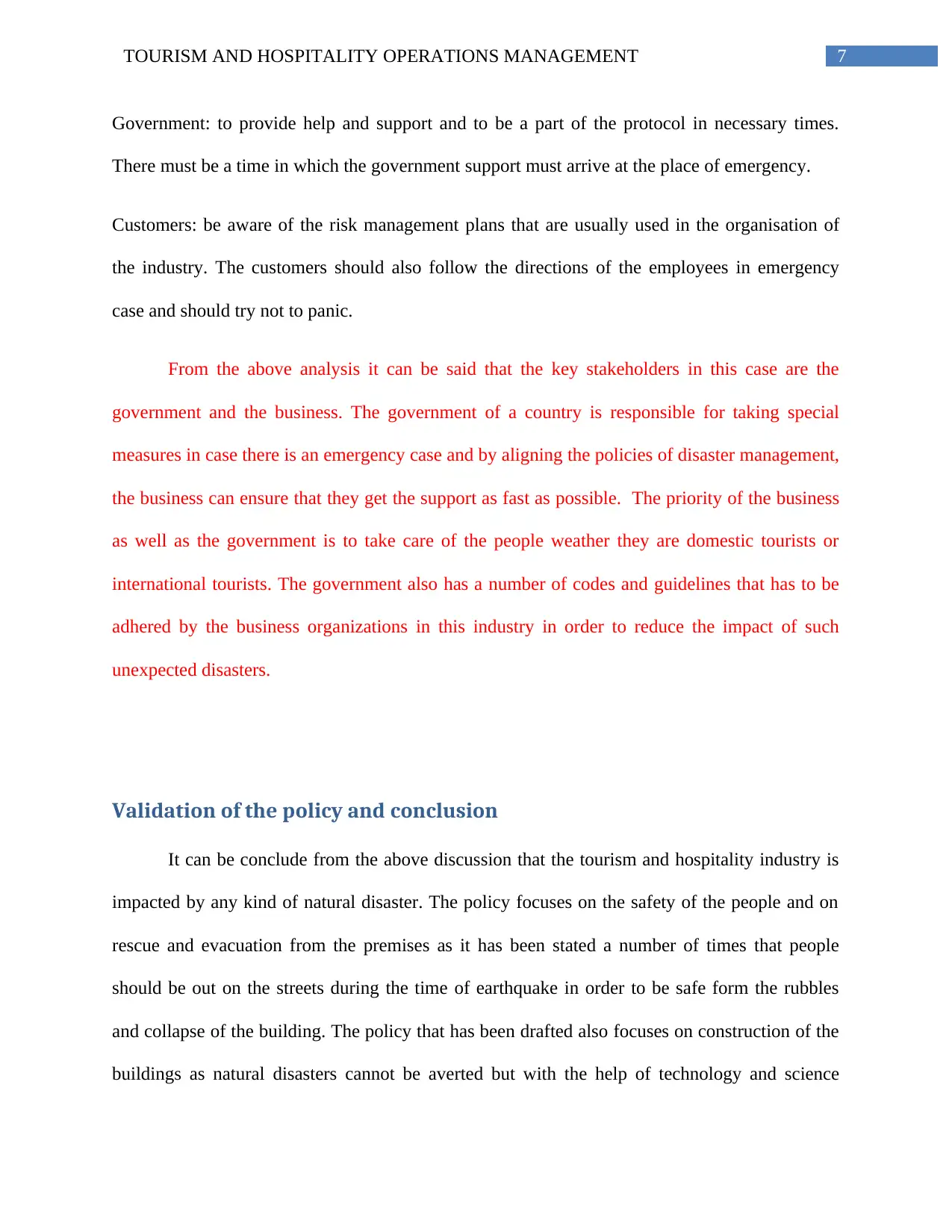
7TOURISM AND HOSPITALITY OPERATIONS MANAGEMENT
Government: to provide help and support and to be a part of the protocol in necessary times.
There must be a time in which the government support must arrive at the place of emergency.
Customers: be aware of the risk management plans that are usually used in the organisation of
the industry. The customers should also follow the directions of the employees in emergency
case and should try not to panic.
From the above analysis it can be said that the key stakeholders in this case are the
government and the business. The government of a country is responsible for taking special
measures in case there is an emergency case and by aligning the policies of disaster management,
the business can ensure that they get the support as fast as possible. The priority of the business
as well as the government is to take care of the people weather they are domestic tourists or
international tourists. The government also has a number of codes and guidelines that has to be
adhered by the business organizations in this industry in order to reduce the impact of such
unexpected disasters.
Validation of the policy and conclusion
It can be conclude from the above discussion that the tourism and hospitality industry is
impacted by any kind of natural disaster. The policy focuses on the safety of the people and on
rescue and evacuation from the premises as it has been stated a number of times that people
should be out on the streets during the time of earthquake in order to be safe form the rubbles
and collapse of the building. The policy that has been drafted also focuses on construction of the
buildings as natural disasters cannot be averted but with the help of technology and science
Government: to provide help and support and to be a part of the protocol in necessary times.
There must be a time in which the government support must arrive at the place of emergency.
Customers: be aware of the risk management plans that are usually used in the organisation of
the industry. The customers should also follow the directions of the employees in emergency
case and should try not to panic.
From the above analysis it can be said that the key stakeholders in this case are the
government and the business. The government of a country is responsible for taking special
measures in case there is an emergency case and by aligning the policies of disaster management,
the business can ensure that they get the support as fast as possible. The priority of the business
as well as the government is to take care of the people weather they are domestic tourists or
international tourists. The government also has a number of codes and guidelines that has to be
adhered by the business organizations in this industry in order to reduce the impact of such
unexpected disasters.
Validation of the policy and conclusion
It can be conclude from the above discussion that the tourism and hospitality industry is
impacted by any kind of natural disaster. The policy focuses on the safety of the people and on
rescue and evacuation from the premises as it has been stated a number of times that people
should be out on the streets during the time of earthquake in order to be safe form the rubbles
and collapse of the building. The policy that has been drafted also focuses on construction of the
buildings as natural disasters cannot be averted but with the help of technology and science
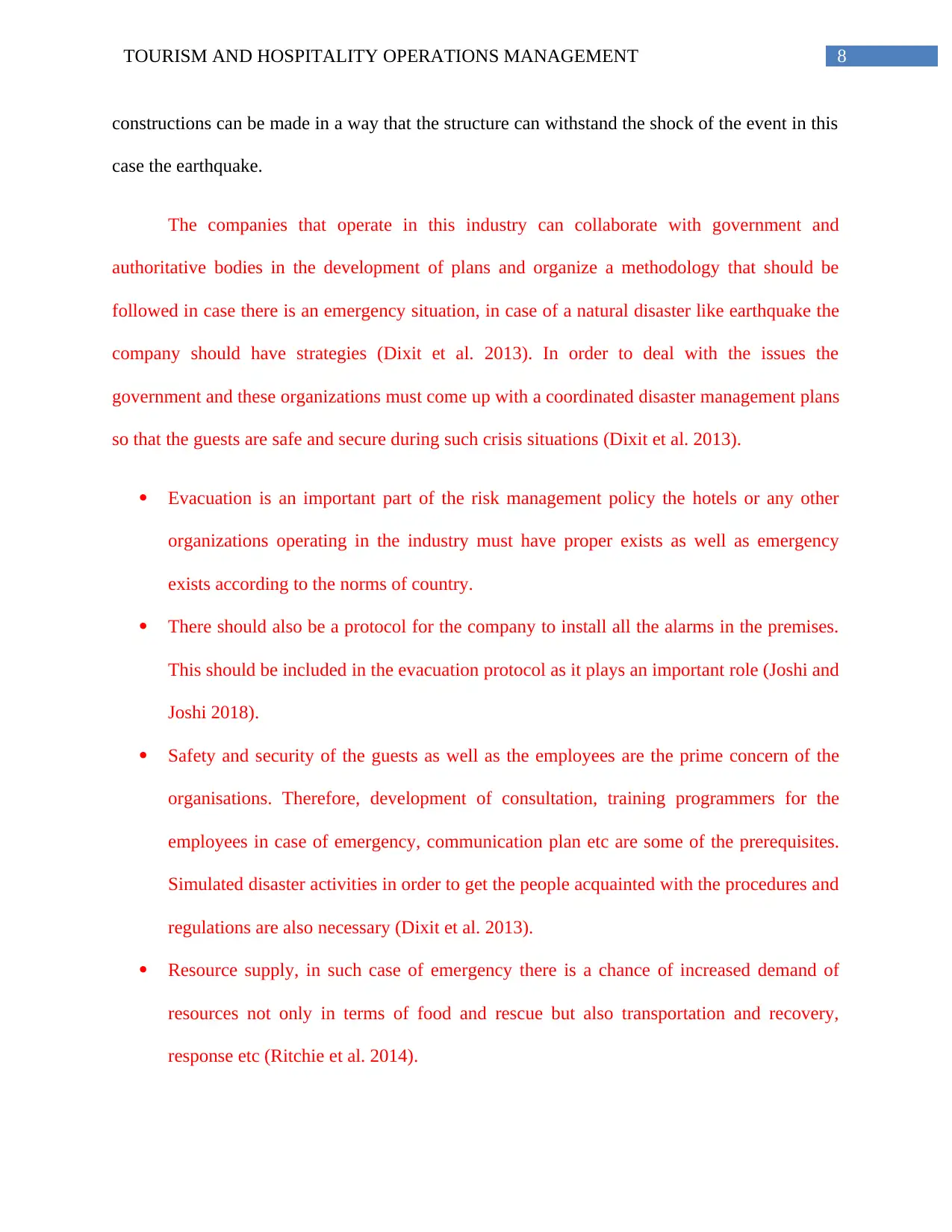
8TOURISM AND HOSPITALITY OPERATIONS MANAGEMENT
constructions can be made in a way that the structure can withstand the shock of the event in this
case the earthquake.
The companies that operate in this industry can collaborate with government and
authoritative bodies in the development of plans and organize a methodology that should be
followed in case there is an emergency situation, in case of a natural disaster like earthquake the
company should have strategies (Dixit et al. 2013). In order to deal with the issues the
government and these organizations must come up with a coordinated disaster management plans
so that the guests are safe and secure during such crisis situations (Dixit et al. 2013).
Evacuation is an important part of the risk management policy the hotels or any other
organizations operating in the industry must have proper exists as well as emergency
exists according to the norms of country.
There should also be a protocol for the company to install all the alarms in the premises.
This should be included in the evacuation protocol as it plays an important role (Joshi and
Joshi 2018).
Safety and security of the guests as well as the employees are the prime concern of the
organisations. Therefore, development of consultation, training programmers for the
employees in case of emergency, communication plan etc are some of the prerequisites.
Simulated disaster activities in order to get the people acquainted with the procedures and
regulations are also necessary (Dixit et al. 2013).
Resource supply, in such case of emergency there is a chance of increased demand of
resources not only in terms of food and rescue but also transportation and recovery,
response etc (Ritchie et al. 2014).
constructions can be made in a way that the structure can withstand the shock of the event in this
case the earthquake.
The companies that operate in this industry can collaborate with government and
authoritative bodies in the development of plans and organize a methodology that should be
followed in case there is an emergency situation, in case of a natural disaster like earthquake the
company should have strategies (Dixit et al. 2013). In order to deal with the issues the
government and these organizations must come up with a coordinated disaster management plans
so that the guests are safe and secure during such crisis situations (Dixit et al. 2013).
Evacuation is an important part of the risk management policy the hotels or any other
organizations operating in the industry must have proper exists as well as emergency
exists according to the norms of country.
There should also be a protocol for the company to install all the alarms in the premises.
This should be included in the evacuation protocol as it plays an important role (Joshi and
Joshi 2018).
Safety and security of the guests as well as the employees are the prime concern of the
organisations. Therefore, development of consultation, training programmers for the
employees in case of emergency, communication plan etc are some of the prerequisites.
Simulated disaster activities in order to get the people acquainted with the procedures and
regulations are also necessary (Dixit et al. 2013).
Resource supply, in such case of emergency there is a chance of increased demand of
resources not only in terms of food and rescue but also transportation and recovery,
response etc (Ritchie et al. 2014).
⊘ This is a preview!⊘
Do you want full access?
Subscribe today to unlock all pages.

Trusted by 1+ million students worldwide
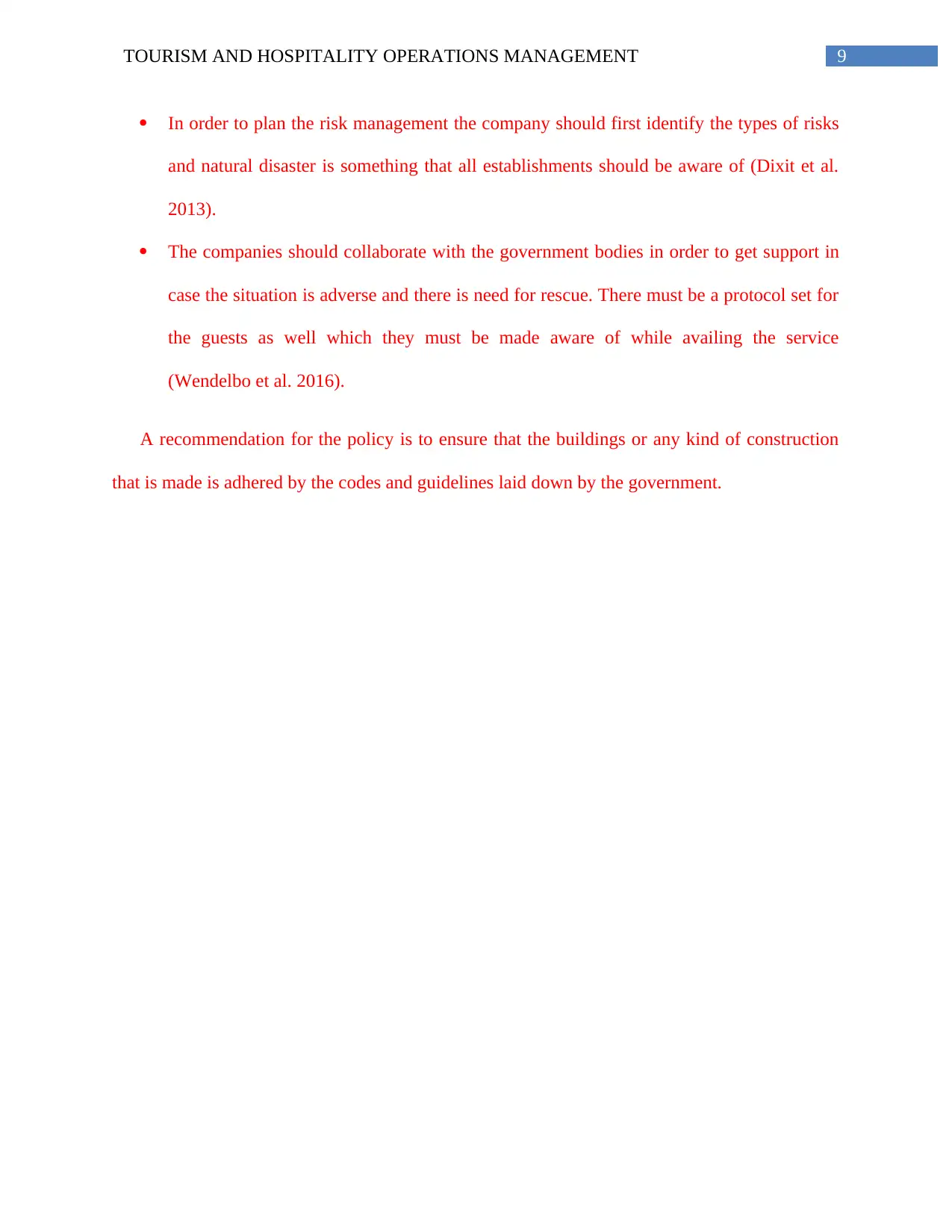
9TOURISM AND HOSPITALITY OPERATIONS MANAGEMENT
In order to plan the risk management the company should first identify the types of risks
and natural disaster is something that all establishments should be aware of (Dixit et al.
2013).
The companies should collaborate with the government bodies in order to get support in
case the situation is adverse and there is need for rescue. There must be a protocol set for
the guests as well which they must be made aware of while availing the service
(Wendelbo et al. 2016).
A recommendation for the policy is to ensure that the buildings or any kind of construction
that is made is adhered by the codes and guidelines laid down by the government.
In order to plan the risk management the company should first identify the types of risks
and natural disaster is something that all establishments should be aware of (Dixit et al.
2013).
The companies should collaborate with the government bodies in order to get support in
case the situation is adverse and there is need for rescue. There must be a protocol set for
the guests as well which they must be made aware of while availing the service
(Wendelbo et al. 2016).
A recommendation for the policy is to ensure that the buildings or any kind of construction
that is made is adhered by the codes and guidelines laid down by the government.
Paraphrase This Document
Need a fresh take? Get an instant paraphrase of this document with our AI Paraphraser
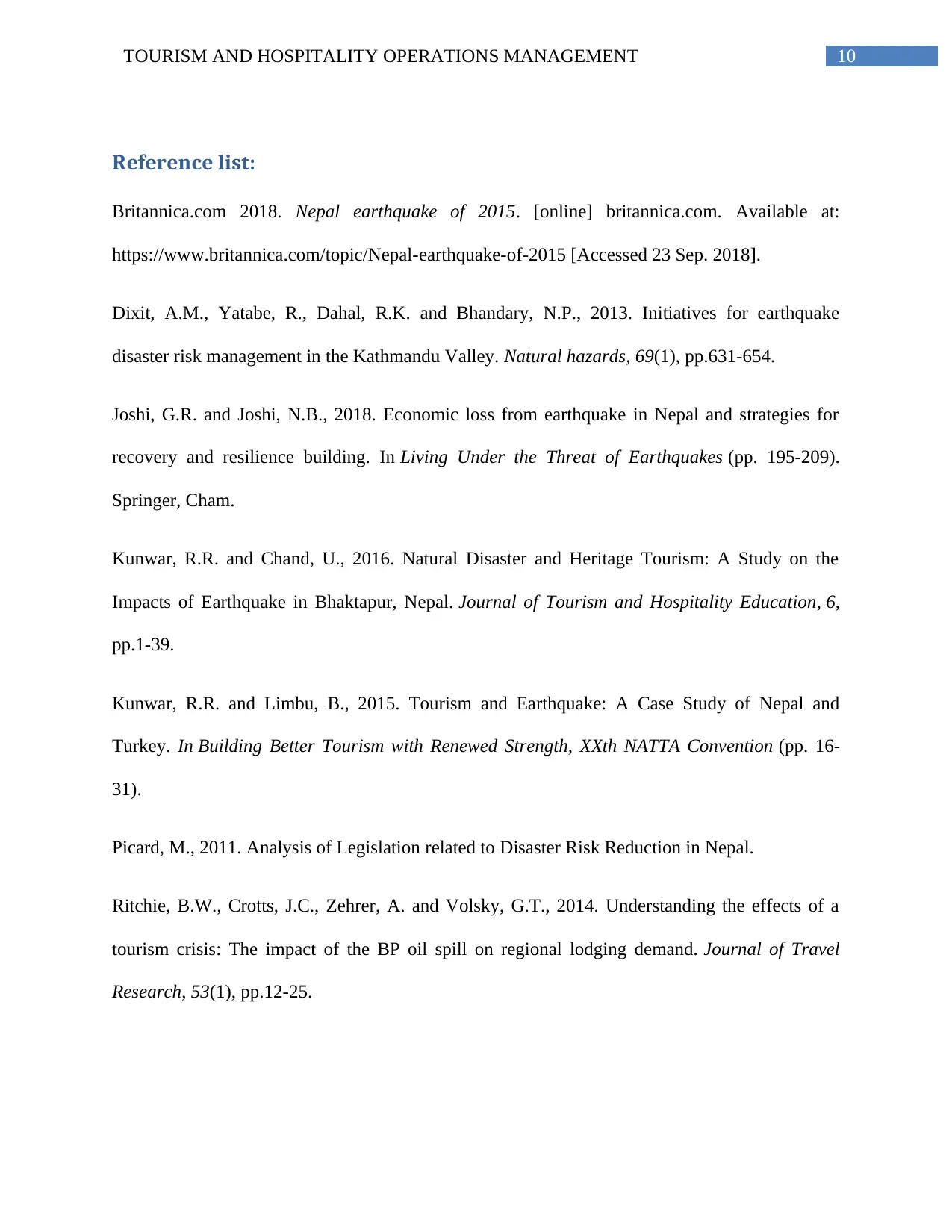
10TOURISM AND HOSPITALITY OPERATIONS MANAGEMENT
Reference list:
Britannica.com 2018. Nepal earthquake of 2015. [online] britannica.com. Available at:
https://www.britannica.com/topic/Nepal-earthquake-of-2015 [Accessed 23 Sep. 2018].
Dixit, A.M., Yatabe, R., Dahal, R.K. and Bhandary, N.P., 2013. Initiatives for earthquake
disaster risk management in the Kathmandu Valley. Natural hazards, 69(1), pp.631-654.
Joshi, G.R. and Joshi, N.B., 2018. Economic loss from earthquake in Nepal and strategies for
recovery and resilience building. In Living Under the Threat of Earthquakes (pp. 195-209).
Springer, Cham.
Kunwar, R.R. and Chand, U., 2016. Natural Disaster and Heritage Tourism: A Study on the
Impacts of Earthquake in Bhaktapur, Nepal. Journal of Tourism and Hospitality Education, 6,
pp.1-39.
Kunwar, R.R. and Limbu, B., 2015. Tourism and Earthquake: A Case Study of Nepal and
Turkey. In Building Better Tourism with Renewed Strength, XXth NATTA Convention (pp. 16-
31).
Picard, M., 2011. Analysis of Legislation related to Disaster Risk Reduction in Nepal.
Ritchie, B.W., Crotts, J.C., Zehrer, A. and Volsky, G.T., 2014. Understanding the effects of a
tourism crisis: The impact of the BP oil spill on regional lodging demand. Journal of Travel
Research, 53(1), pp.12-25.
Reference list:
Britannica.com 2018. Nepal earthquake of 2015. [online] britannica.com. Available at:
https://www.britannica.com/topic/Nepal-earthquake-of-2015 [Accessed 23 Sep. 2018].
Dixit, A.M., Yatabe, R., Dahal, R.K. and Bhandary, N.P., 2013. Initiatives for earthquake
disaster risk management in the Kathmandu Valley. Natural hazards, 69(1), pp.631-654.
Joshi, G.R. and Joshi, N.B., 2018. Economic loss from earthquake in Nepal and strategies for
recovery and resilience building. In Living Under the Threat of Earthquakes (pp. 195-209).
Springer, Cham.
Kunwar, R.R. and Chand, U., 2016. Natural Disaster and Heritage Tourism: A Study on the
Impacts of Earthquake in Bhaktapur, Nepal. Journal of Tourism and Hospitality Education, 6,
pp.1-39.
Kunwar, R.R. and Limbu, B., 2015. Tourism and Earthquake: A Case Study of Nepal and
Turkey. In Building Better Tourism with Renewed Strength, XXth NATTA Convention (pp. 16-
31).
Picard, M., 2011. Analysis of Legislation related to Disaster Risk Reduction in Nepal.
Ritchie, B.W., Crotts, J.C., Zehrer, A. and Volsky, G.T., 2014. Understanding the effects of a
tourism crisis: The impact of the BP oil spill on regional lodging demand. Journal of Travel
Research, 53(1), pp.12-25.
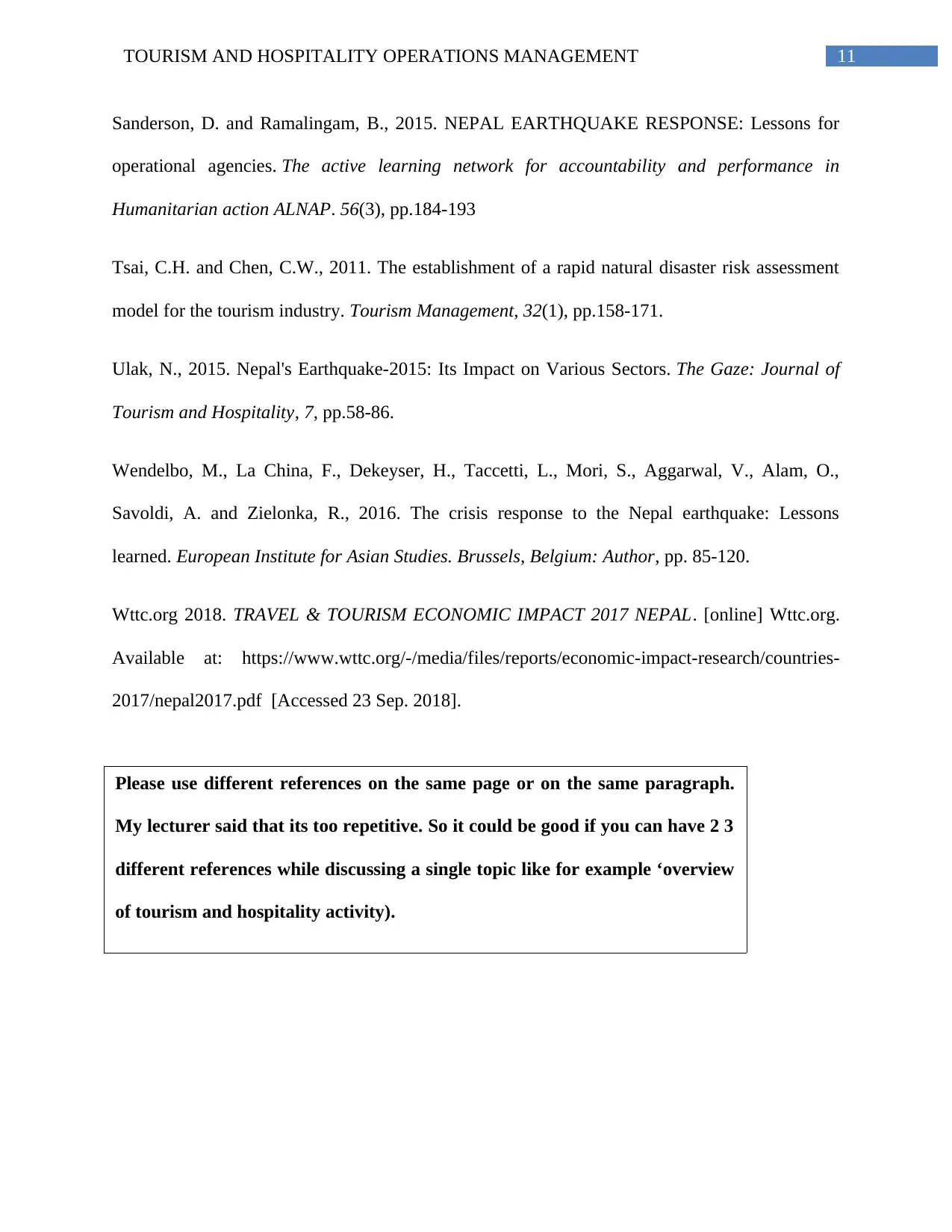
11TOURISM AND HOSPITALITY OPERATIONS MANAGEMENT
Sanderson, D. and Ramalingam, B., 2015. NEPAL EARTHQUAKE RESPONSE: Lessons for
operational agencies. The active learning network for accountability and performance in
Humanitarian action ALNAP. 56(3), pp.184-193
Tsai, C.H. and Chen, C.W., 2011. The establishment of a rapid natural disaster risk assessment
model for the tourism industry. Tourism Management, 32(1), pp.158-171.
Ulak, N., 2015. Nepal's Earthquake-2015: Its Impact on Various Sectors. The Gaze: Journal of
Tourism and Hospitality, 7, pp.58-86.
Wendelbo, M., La China, F., Dekeyser, H., Taccetti, L., Mori, S., Aggarwal, V., Alam, O.,
Savoldi, A. and Zielonka, R., 2016. The crisis response to the Nepal earthquake: Lessons
learned. European Institute for Asian Studies. Brussels, Belgium: Author, pp. 85-120.
Wttc.org 2018. TRAVEL & TOURISM ECONOMIC IMPACT 2017 NEPAL. [online] Wttc.org.
Available at: https://www.wttc.org/-/media/files/reports/economic-impact-research/countries-
2017/nepal2017.pdf [Accessed 23 Sep. 2018].
Please use different references on the same page or on the same paragraph.
My lecturer said that its too repetitive. So it could be good if you can have 2 3
different references while discussing a single topic like for example ‘overview
of tourism and hospitality activity).
Sanderson, D. and Ramalingam, B., 2015. NEPAL EARTHQUAKE RESPONSE: Lessons for
operational agencies. The active learning network for accountability and performance in
Humanitarian action ALNAP. 56(3), pp.184-193
Tsai, C.H. and Chen, C.W., 2011. The establishment of a rapid natural disaster risk assessment
model for the tourism industry. Tourism Management, 32(1), pp.158-171.
Ulak, N., 2015. Nepal's Earthquake-2015: Its Impact on Various Sectors. The Gaze: Journal of
Tourism and Hospitality, 7, pp.58-86.
Wendelbo, M., La China, F., Dekeyser, H., Taccetti, L., Mori, S., Aggarwal, V., Alam, O.,
Savoldi, A. and Zielonka, R., 2016. The crisis response to the Nepal earthquake: Lessons
learned. European Institute for Asian Studies. Brussels, Belgium: Author, pp. 85-120.
Wttc.org 2018. TRAVEL & TOURISM ECONOMIC IMPACT 2017 NEPAL. [online] Wttc.org.
Available at: https://www.wttc.org/-/media/files/reports/economic-impact-research/countries-
2017/nepal2017.pdf [Accessed 23 Sep. 2018].
Please use different references on the same page or on the same paragraph.
My lecturer said that its too repetitive. So it could be good if you can have 2 3
different references while discussing a single topic like for example ‘overview
of tourism and hospitality activity).
⊘ This is a preview!⊘
Do you want full access?
Subscribe today to unlock all pages.

Trusted by 1+ million students worldwide
1 out of 12
Your All-in-One AI-Powered Toolkit for Academic Success.
+13062052269
info@desklib.com
Available 24*7 on WhatsApp / Email
![[object Object]](/_next/static/media/star-bottom.7253800d.svg)
Unlock your academic potential
Copyright © 2020–2025 A2Z Services. All Rights Reserved. Developed and managed by ZUCOL.

